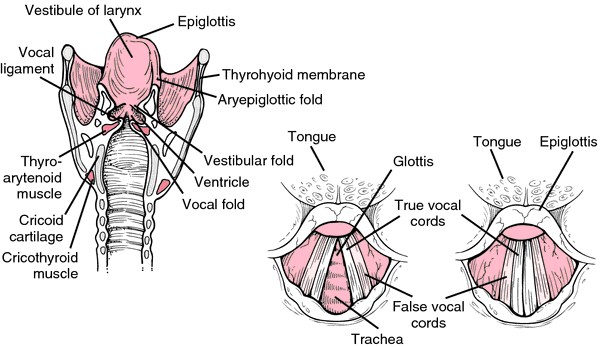larynx
[lar´ingks] (Gr.)the muscular and cartilaginous structure, lined with mucous membrane, situated at the top of the trachea and below the root of the tongue and the hyoid bone; it contains the vocal cords and is the source of the sound heard in speech. The larynx is part of the respiratory system; air passes through it traveling from the pharynx to the trachea on its way to the lungs and again returning to the exterior.
The larynx is composed of nine cartilages that are held together by muscles and ligament: the single thyroid, cricoid, and epiglottic cartilages and the paired arytenoid, corniculate, and cuneiform cartilages. (See also color plates.) The largest of these, the thyroid cartilage, forms the Adam's apple, which protrudes in the front of the neck. Two flexible vocal cords reach from the back to the front wall of the larynx and are manipulated by small muscles to produce sound. The epiglottis, a flap or lid at the base of the tongue, closes the larynx as it is lifted up during swallowing and so prevents passage of food or drink into the larynx and trachea.
The larynx is composed of nine cartilages that are held together by muscles and ligament: the single thyroid, cricoid, and epiglottic cartilages and the paired arytenoid, corniculate, and cuneiform cartilages. (See also color plates.) The largest of these, the thyroid cartilage, forms the Adam's apple, which protrudes in the front of the neck. Two flexible vocal cords reach from the back to the front wall of the larynx and are manipulated by small muscles to produce sound. The epiglottis, a flap or lid at the base of the tongue, closes the larynx as it is lifted up during swallowing and so prevents passage of food or drink into the larynx and trachea.

Larynx.
artificial larynx an electromechanical device that enables a person after laryngectomy to produce speech. When the device is placed against the region of the laryngectomy a buzzing sound is made that can be converted into simulated speech by movements of the lips, tongue, and glottis. Called also electrolarynx.
Miller-Keane Encyclopedia and Dictionary of Medicine, Nursing, and Allied Health, Seventh Edition. © 2003 by Saunders, an imprint of Elsevier, Inc. All rights reserved.
lar·ynx
, pl.la·ryn·ges
(lar'ingks, lă-rin'jēz), Avoid the misspelling/mispronunciation larnyx.The organ of voice production; the part of the respiratory tract between the pharynx and the trachea; it consists of a framework of cartilages and elastic membranes housing the vocal folds and the muscles that control the position and tension of these elements.
[Mod. L. fr. G.]
Farlex Partner Medical Dictionary © Farlex 2012
larynx
(lăr′ĭngks)n. pl. larynges (lə-rĭn′jēz) or larynxes
The part of the respiratory tract between the pharynx and the trachea, having walls of cartilage and muscle and containing the vocal cords enveloped in folds of mucous membrane.
The American Heritage® Medical Dictionary Copyright © 2007, 2004 by Houghton Mifflin Company. Published by Houghton Mifflin Company. All rights reserved.
larynx
The region of the throat between the pharynx (tip of the epiglottis) and trachea (cricoid cartilage) which contains the vocal cords and is involved in breathing, swallowing, and speech.Boundaries
• Superolateral boundary—Tip of the epiglottis and aryepiglottic folds.
• Inferior limit—Inferior rim of the cricoid cartilage.
• Posterior limit—Posterior mucosa covering cricoid cartilage, arytenoid region, and interarytenoid space.
• Anterior limit—Lingual surface of epiglottis, thyrohyoid membrane, anterior commissure, thyroid cartilage, cricothyroid membrane, and anterior arch of the cricoid cartilage.
Regions
Supraglottis, glottis, subglottis.
Segen's Medical Dictionary. © 2012 Farlex, Inc. All rights reserved.
lar·ynx
, pl. larynges (laringks, lă-rinjēz) [TA]The organ of voice production, which also serves a protective function for the airway; the part of the respiratory tract between the pharynx and the trachea: it consists of a framework of cartilages and elastic membranes housing the vocal folds and the muscles that control the position and tension of these elements.
[Mod. L. fr. G.]
Medical Dictionary for the Health Professions and Nursing © Farlex 2012
larynx
The ‘Adam's apple’ or voice box. The larynx is situated at the upper end of the wind-pipe (TRACHEA), just in front of the start of the gullet (OESOPHAGUS). At its inlet is a leaf-shaped flap of cartilage, the EPIGLOTTIS, that prevents entry of swallowed food. It has walls of cartilage and is lined with a moist mucous membrane and contains the vocal cords. These are two folds of the mucous membrane that can be tensed by tiny muscles to control their rate of vibration as air passes through them, and hence the pitch of the voice. The gap between the folds is called the glottis.Collins Dictionary of Medicine © Robert M. Youngson 2004, 2005
larynx
a dilation of the upper part of the TRACHEA of TETRAPODS (Adam's apple in humans), occurring in the front part of the neck. It is triangular in shape (base uppermost) and is made up of 9 cartilages moved by muscles. It contains the vocal cords which are elastic ligaments embedded in two folds of mucous membrane.Collins Dictionary of Biology, 3rd ed. © W. G. Hale, V. A. Saunders, J. P. Margham 2005
Larynx
Also known as the voice box, the larynx is composed of cartilage that contains the apparatus for voice production. This includes the vocal cords and the muscles and ligaments that move the cords.
Gale Encyclopedia of Medicine. Copyright 2008 The Gale Group, Inc. All rights reserved.
lar·ynx
, pl. larynges (laringks, lă-rinjēz) [TA]Organ of voice production; part of respiratory tract between pharynx and trachea.
[Mod. L. fr. G.]
Medical Dictionary for the Dental Professions © Farlex 2012